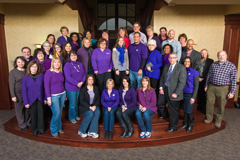February 23, 2015
Letter from V.P. for human capital services Cheryl Johnson

Feb. 9-13, I had the pleasure of working with 33 of our colleagues across campus to examine and analyze ways we can improve our current hiring process. We invested 40 hours to map our processes and outline an optimal future plan at the K-State Kaizen — an organizational practice for continuous improvement.
We discovered that currently there are more than 100 steps, 77 hand-offs and multiple re-loops to hire an employee at K-State. Historically, I believe we evolved into this complex process by well-intentioned, opinionated stakeholders infusing steps as it related to their individual silos without looking at the system holistically.
Perhaps the evolution of our current process is analogous to a story I read about a grandfather who took his grandson to town on a donkey. He started off letting his grandson ride the donkey as he walked alongside. A few miles down the road a man passed by and said, "I can’t believe how we treat our elderly. Look at that selfish boy making that old man walk." The grandfather heard it and took the boy off the donkey. He then rode the donkey as his grandson walked by his side. A few miles later a woman passed by and said, "Look at that old man making that little boy walk on the dusty road while he rides the donkey. I should report him to child protection services." Hearing that, the grandfather pulled the little boy up with him and they both started riding the donkey. A few minutes later, another person passed by and said, "How cruel of you and the boy to place such a heavy load on the donkey." By the time they got to town, the grandfather and grandson were carrying the donkey.
Our highly fragmented hiring process is fraught with too many steps, too many hand-offs, too many re-loops. The Kaizen event provided the methodology to look at the hiring process in its entirety.
We identified several solutions that will streamline and improve the hiring process, and build diverse and inclusive candidate slates while honoring all legal requirements. This will support our K-State 2025 goal to recruit and retain a highly talented and diverse workforce.
A few procedural improvements from the Kaizen include:
- Streamlining the approval process.
- Re-engineering the hiring process at its onset so that Human Capital Services collaborates and provides recommendations for strategically sourcing applicant pools to garner a diverse and inclusive candidate slate.
- Developing a user-friendly hiring guide.
- Creating position numbers within colleges and departments.
- Providing a standardized list of places to advertise jobs to gain pricing discounts and measure the sources that render the most diverse talent. This is in addition to the unique places colleges or departments advertise for specialized hiring.
- Consolidating several appendices.
- Eliminating the PER-20, or Spoken English Language Competency, for re-hires.
- Consolidating the offer and contract process.
- Re-engineering the background check.
- Starting the H1-B process earlier. An H-1B is a non-immigrant visa in the United States under the Immigration and Nationality Act, section 101(a)(15)(H). It allows U.S. employers to temporarily employ foreign workers in specialty occupations.
- Creating candidate pools for similar positions throughout the university.
We will implement process improvements over the next several months, networking with a variety of colleagues. We want to ensure we cast the broadest net possible to recruit a highly talented and diverse workforce and implement an automated system to support our new and improved hiring process.
We look forward to beta testing these solutions with the College of Veterinary Medicine and the Information Systems Office. In summary, we finally will be riding the donkey rather than carrying the donkey to town.
Thank you to all who participated in the Kaizen. You were a wonderful help in reshaping our hiring process.
Sincerely,
Cheryl Johnson
Vice president for human capital
